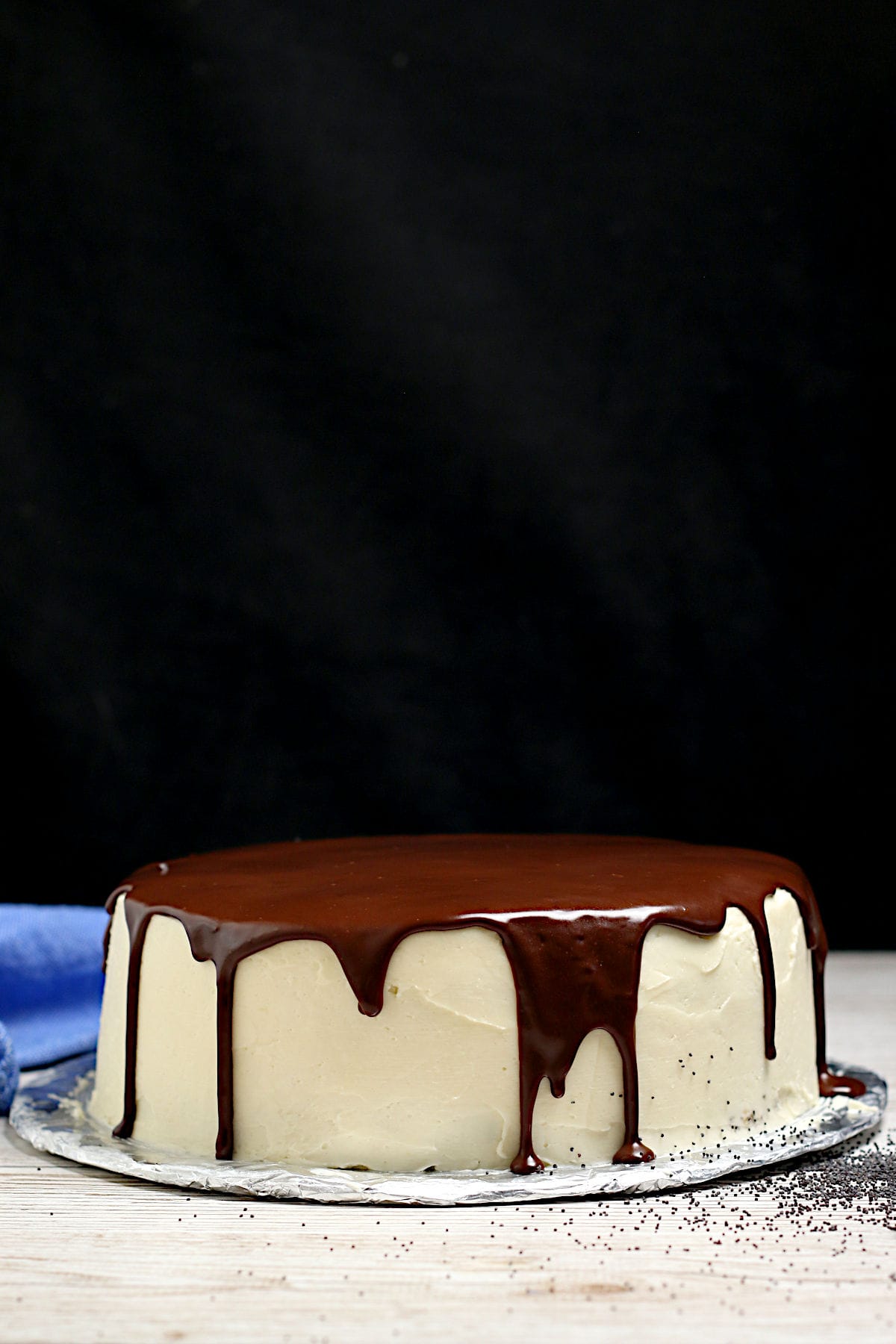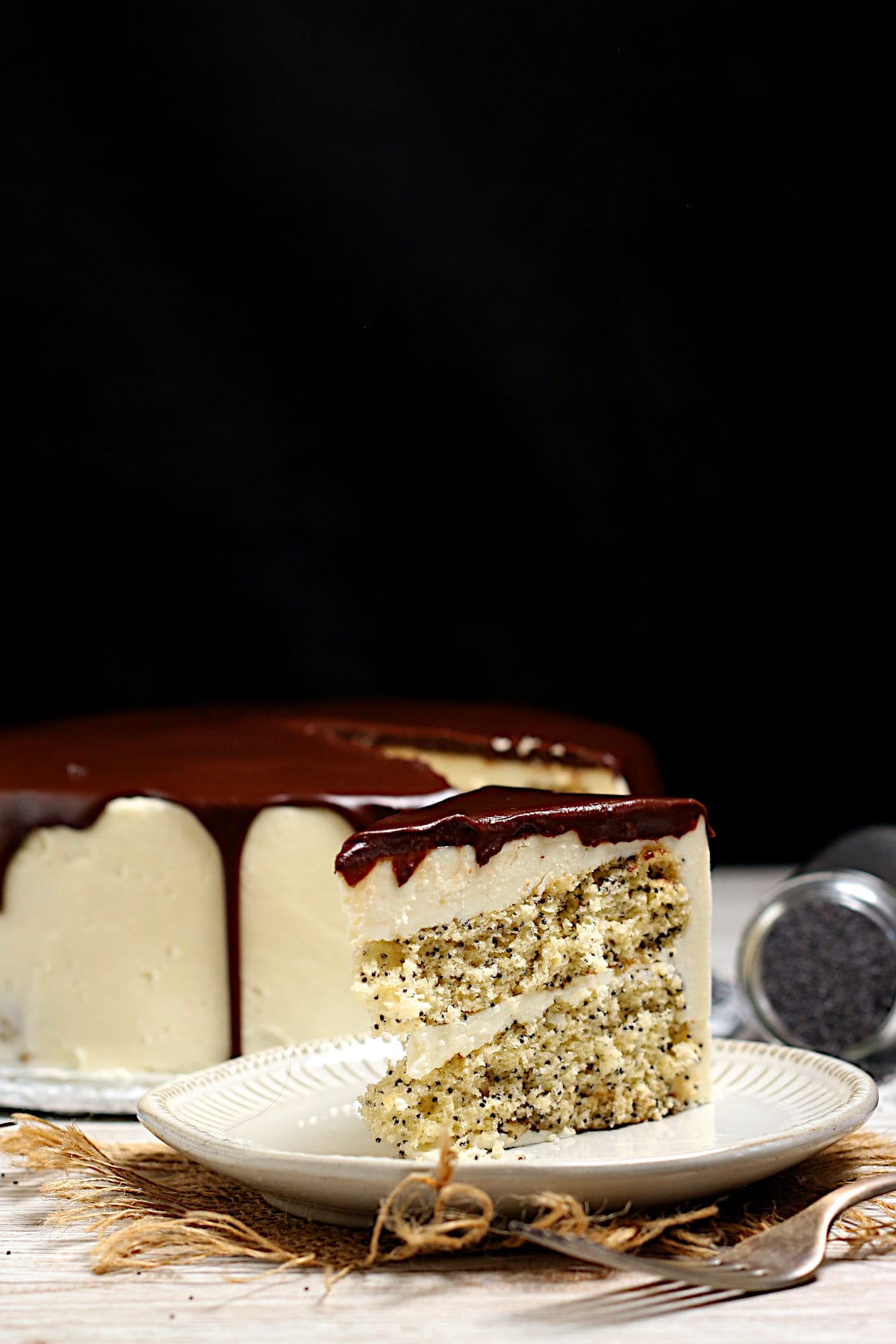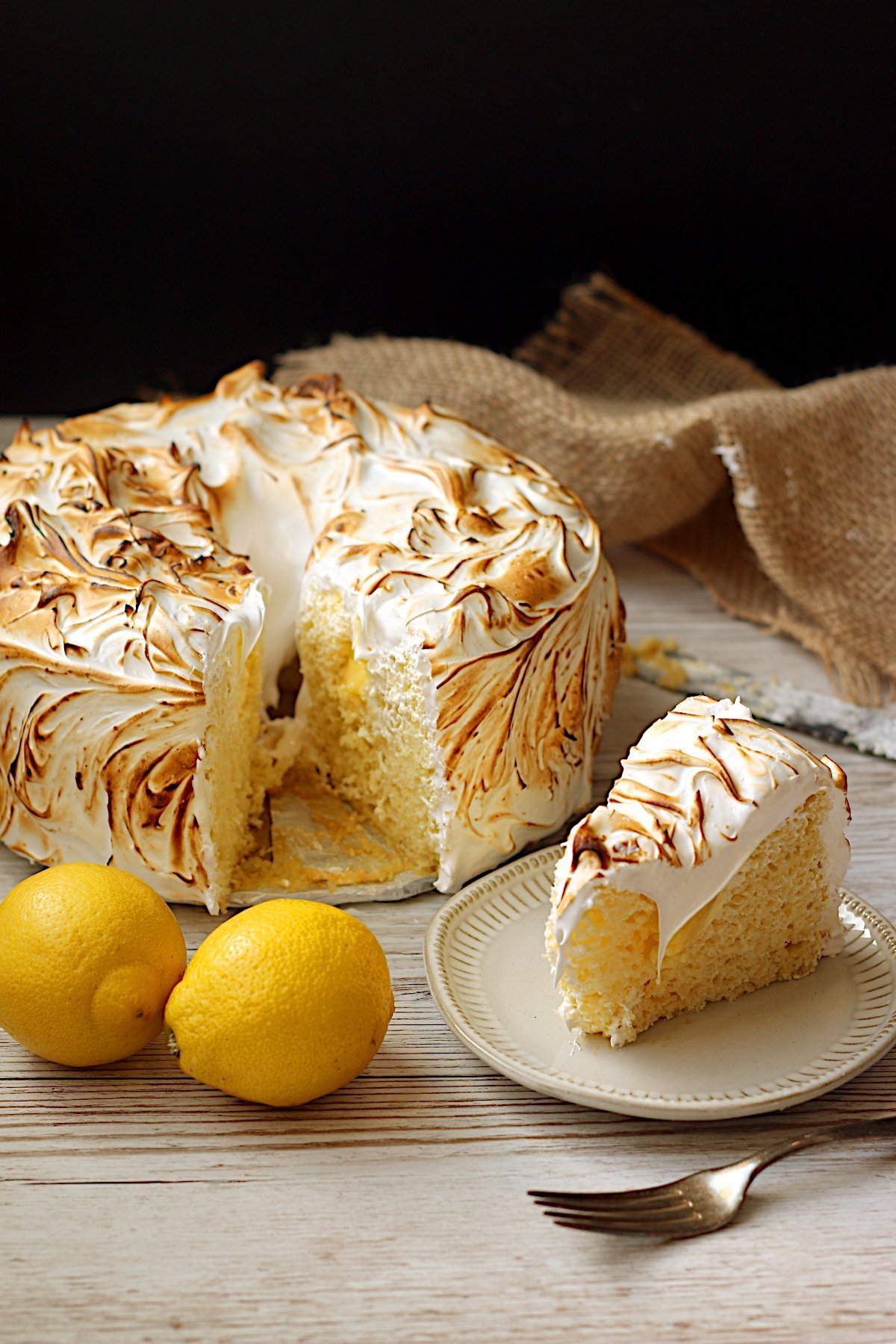Poppyseed Sponge Cake with Vanilla Frosting and Chocolate Ganache
This Poppyseed Sponge Cake features a fluffy, poppyseed-studded cake, a smooth, sweet vanilla buttercream, and a rich dark chocolate ganache.
Many years ago, a family friend brought a cake that I loved to a dinner party. It was a single-layer poppyseed sheet cake with a layer of creamy buttercream, and a layer of chocolate on top of that.
I’ve thought of that cake off and on over the years, with thoughts of maybe one day trying to recreate it, or at least something like it. This year, I did just that for my recent birthday. I ended up with this Poppyseed Sponge Cake with Vanilla Buttercream and Chocolate Ganache.
It’s been so long since I had that original cake that I don’t even really know if this one is really even all that similar to it, but it was great anyway. Read on to find out how to make it.

How to Make Poppyseed Sponge Cake
Making this cake involves making three separate components, and admittedly, it is a bit of a time investment (like most celebration cakes). However, much of that time is hands-off (waiting for the cake to cook/cool/chill).
Poppyseed Sponge Cake
Making the poppyseed sponge cake starts with whipping the eggs with the sugar. For best results, make sure your eggs are at room temperature (to speed this along, you can put the eggs in warm – not hot – water).
Once the egg mixture is foamy and forms medium peaks, you can sift half of the flour mixture (all-purpose flour, cornstarch, baking powder, and salt) over the eggs, then gently fold it in. Once no more flour streaks remain, sift the remaining flour mixture over the batter and repeat the folding process. Gently fold in the poppyseed.
Divide the batter into two equal portions (use a kitchen scale to be precise) and pour into two 9-inch cake pans that have been lined with parchment paper. Bake until the cakes are golden brown and spring back when poked.
Cool the cakes on a wire rack, then remove the cakes from the pan by running a paring knife or offset spatula around the edges before turning the cake pan over a plate or cutting board.

Buttercream Frosting
To make the frosting, you’ll want to start with your ingredients at room temperature. First, whip the butter and salt together until fluffy. Add the powdered sugar, and mix at low speed until it’s incorporated. Increase the speed to medium-high and beat until fluffy.
Gradually pour in the cream and continue whipping. At some point, it may appear to “break” or look clumpy or curdled. This is normal. Continue beating, and it will come together. When the frosting appears light and fluffy, add the vanilla and whip for another minute.
Once the cakes are completely cool, scoop about ¼ of the frosting onto the top of one of the cakes and spread it evenly over the top. Place the second cake on top of the first. Scoop approximately 1/3 to 1/2 of the remaining frosting on top of the cake. Spread it evenly over the cake in a thin layer (don’t worry too much about how it looks or whether there are crumbs in it). Chill the cake in the fridge or freezer for at least 15 minutes.
Scoop the remaining frosting onto the top of the cake, spreading evenly over the top and sides. This time, be careful not to get any crumbs into the frosting (they should all be locked in place by the first layer of frosting anyway), and get the frosting as smooth as possible. Chill the cake again.
Chocolate Ganache
The chocolate ganache is simple to make. Simply heat the cream to steaming in a small saucepan (or in the microwave). Remove the saucepan from the heat, add the chocolate, and cover the saucepan. Let it sit until the chocolate melts (about 5 minutes). Stir the mixture until it’s evenly mixed. Let the mixture cool for 15 minutes before adding it to the cake.
Pour the ganache onto the center of the cake. Continue to pour until the entire top of the cake is covered, and the ganache creates drips down the sides of the cake.
Note that this cake is best served at room temperature, but should be stored in the fridge if you need to keep it for several hours before serving (eg. overnight). Leftovers can be stored for an extended period in the freezer. Thaw at room temperature before serving.

Poppyseed Sponge Cake Ingredients
- All-purpose flour – I don’t like keeping multiple types of flour on hand for baking, so I often make a DIY version of cake flour when I make cakes. Cake flour is lower in protein than all-purpose flour, which creates a more tender cake. A DIY version involves mixing all-purpose flour with cornstarch. Alternatively, you can use cake flour (find the amount in the recipe notes below).
- Cornstarch – Using some cornstarch with all-purpose flour replicates cake flour (see above).
- Salt – You will use salt (in small amounts) in both the cake batter and the buttercream.
- Baking powder – While traditional sponge cakes rely solely on whipped eggs to leaven them, most modern sponge cakes use a bit of baking powder for extra leavening.
- Large eggs – Eggs provide the majority of the bulk of a sponge cake. Whipping air into them with sugar to create a stable foam provides the majority of the leavening. For best results, bring eggs to room temperature before whipping.
- Granulated sugar – You will be whipping sugar with the eggs to make the cake batter.
- Poppyseed – Poppyseed cakes (and using poppyseeds in other sweet baked goods) are common in central and eastern Europe. You can find poppyseed in small jars or packets, usually in the spice aisle. It is true that eating poppyseed can create a false positive for opioids in drug testing, but they don’t actually contain any drugs or make you high when consumed in any amount.
- Unsalted butter – You will be using unsalted butter to make the buttercream. You can use salted butter instead. In that case, skip the salt in the frosting. It should be softened before attempting to whip it.
- Powdered sugar – There really is no good substitute for powdered sugar to make frosting, so don’t attempt to use something else.
- Heavy cream – This buttercream is a little different than most in that it contains a large amount of heavy cream. This creates a smoother and lighter frosting. You will also be using heavy cream in the chocolate ganache.
- Vanilla extract – This is used in the buttercream to give it a vanilla flavor.
- Dark chocolate – I prefer to use a chopped dark chocolate bar, because they are typically higher quality than chocolate chips. However, you can use chocolate chips as well.

Want more celebration cake recipes?
Poppyseed Sponge Cake Nutrition Notes
The nutrition information in the recipe below is for 1/12th of the cake, and includes both frosting and chocolate ganache. If you cut your cake slices larger (or smaller) than this, the nutrition information will vary accordingly.
Equipment
Ingredients
Instructions
- Prepare two 9" cake pans by lining the bottoms with parchment paper (trace around the bottom of the pan to get the right size). DO NOT grease the sides of the pans. Set aside for now.
- Move the oven rack to the middle position and heat the oven to 350°F.
- In a medium bowl, whisk together 137 grams (18 Tablespoons) all-purpose flour, 20 grams (3 Tablespoons) cornstarch, 3 grams (½ teaspoon) salt, and 2 grams (½ teaspoon) baking powder. Set the mixture aside for now.
- Add 7 large eggs to the bowl of a stand mixer (or to a large bowl). Beat on medium-high speed for 1-2 minutes until foamy. Add 200 grams (1 cup) granulated sugar, a little bit at a time, while continuing to beat the eggs until fluffy and hold a medium peak, about 8-10 minutes.
- Sift half of the flour mixture over the whipped eggs, and gently fold the flour in with a spatula, making sure that there are no streaks of flour remaining. Repeat with the second half of the flour mixture. Sprinkle 25 grams (¼ cup) poppyseed over the batter and fold in with a spatula until evenly distributed.
- Divide the batter evenly between the two prepared cake pans (using a kitchen scale is the most precise way to do this) and bake for 22-27 minutes until the cakes are golden brown on the top and the tops spring back when gently poked. Place the cakes on a wire rack to cool completely, about an hour.
- Remove the cakes from the pans by running a paring knife or offset spatula around the edges of the pan, then turning the pan upside down over a cutting board or other flat surface. Peel off the parchment paper carefully.
- Place 227 grams (1 cup) softened unsalted butter and 3 grams (½ teaspoon) salt in the bowl of your stand mixer. Beat on medium-high speed until it appears paler and fluffy, about 3-4 minutes. Add 360 grams (3 cups) powdered sugar and turn the mixer on low speed until the sugar is mixed in. Increase the mixer to medium-high speed and mix until fluffy, another 3-4 minutes. Add 238 grams (1 cup) heavy cream, a few tablespoons at a time, while continuing to mix. Note that there will likely come a point when the mixture appears broken and/or curdled. Don't worry, and just keep mixing. It will come back together. Add 4 grams (1 teaspoon) vanilla extract and mix for another minute.
- Heat 100 grams (7 Tablespoons) heavy cream over medium-high heat in a small saucepan until steaming (alternatively, you can heat it on high heat in the microwave in a large microwave-safe measuring cup or medium bowl). Remove the saucepan from heat and add 100 grams (3.5 ounces) dark chocolate. Cover the saucepan and let sit for about 5 minutes until the chocolate is melted. Stir gently until the mixture is uniform. Let cool for about 15 minutes before pouring onto the cake.
- Place one of the cakes on a platter or cake board, using a dab of frosting to prevent it from sliding around, if desired. To make frosting easier, place the cake onto a cake turntable. Scoop about ¼ of the frosting onto the top of the cake and use an offset spatula to spread it evenly. Place the second cake on top.
- Scoop approximately ⅓ to ½ of the remaining frosting onto the top of the second cake. Use an offset spatula to spread the frosting evenly over the top and sides of the cake. Note that this layer of frosting should be quite thin, and it doesn't matter if there are crumbs in it. Place the entire cake in the fridge or freezer to chill for at least 15 minutes.
- Once the crumb coat of frosting on the cake is set, scoop all of the remaining frosting onto the top of the cake (make sure to clean your offset spatula if there are crumbs on it). Carefully and evenly spread the frosting over the top and sides of the cake, trying to get it as smooth as possible. When you're done frosting, I recommend chilling the cake again to prevent the warm ganache from melting the frosting.
- Check the consistency of the ganache. If it has thickened so much that it's no longer pourable, gently warm it until it's thin enough to pour. Pour the ganache into the center of the cake, making sure it reaches all of the edges and creates even drips around the cake.
- If you aren't serving the cake right away, carefully cover the cake (I always use a cake carrier for the easiest storage), and refrigerate the cake. Take the cake out of the fridge at least an hour before serving to allow it to come to room temperature.
Nutrition
Notes
Tried this recipe?
Please Consider Leaving a Review!*** Frosting barely adapted from Milk Street 1-2-3 Frosting





